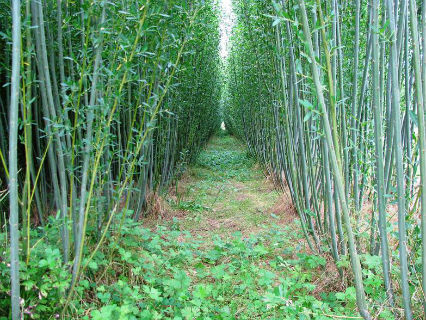
Grown for biofuel, energy-efficient shrub willow sequesters carbon below-ground, life-cycle assessment shows.
- Research Purpose
- Research Activities
- What We Have Learned
- Why This is Important
- For More Information
- Contributors to this Summary
Abstract
Shrub willow is a short-rotation woody biomass crop that could be an important part of our renewable energy future. By sequestering carbon in below-ground biomass, it can offset any greenhouse gas (GHG) emissions created during its production and transportation to a biorefinery. Research is proving it to be a crop with a high net energy ratio—that is, it provides more energy than is used to produce and process it—and low GHG footprint, even with the variability of the shrub willow’s performance under different management practices.
Research Purpose
Short-rotation woody crops such as shrub willow could provide between 126 and 315 million dry tons of biomass for use as biofuels by the year 2030, according to the U.S. Billion-Ton Update report by the U.S. Department of Energy. That would be nearly 30 percent of the biomass estimated to be available from agricultural and forest sources in 2030.

Perennial crops, like the willow, that will contribute to our renewable-energy future must be energy-efficient in their production and processing. They must be low-carbon sources that don’t add more GHG emissions into the atmosphere than they replace.
Finding crops that will work as renewable sources for our energy future requires measuring the amount of energy they use up over the crop’s entire life cycle, from planting to hauling to a biorefinery for processing into the final product, as well as how much GHG they emit. Crops that emit more GHG and use up more energy than they provide are not sustainable in the long run.
Research by Jesse Caputo of the Department of Forest and Natural Resources Management at the SUNY College of Environmental Science and Forestry and his colleagues used a life-cycle assessment (LCA) model to measure the fossil fuel inputs and GHG balance of shrub willow cropping systems in New York state, incorporating some of the key variables that add uncertainty to LCA models.

Research Activities
Caputo and colleagues developed an LCA model to measure GHG emissions and carbon sequestration in eight different management scenarios for shrub willow grown for bioenergy in New York. The scenarios varied in crop yield, fertilizer use, and the distance the biomass had to be hauled to biorefinery, where the shrub willow crop would be processed into a biofuel.
They constructed a computer model, using commercial software, to estimate use of fossil fuels and GHG emissions over the crop’s life cycle of seven three-year harvest rotations, the practical lifetime of a shrub willow stand grown for biofuels. The cycle stretched from planting and growing the crop, to harvesting the shrub willow as chips, and storing and transporting the shrub willow chips from the field to a biorefinery.
Because crop production is highly variable, there can be a great deal of uncertainty in determining the shrub willow’s performance as a bioenergy crop. To incorporate that uncertainty into the research, Caputo documented the variability of three important biological parameters–yield, underground carbon sequestration, and the nitrogen content of decayed leaf litter. Better incorporation of data uncertainty into LCA models should, in the future, provide a clearer picture of how well shrub willow performs as an energy-efficient source of renewable energy.
What We Have Learned
Shrub willow provides a large sink for sequestering carbon below ground. New data on underground biomass, in fact, shifted the shrub willow from a low-carbon bioenergy source to one which sequesters carbon, more than offsetting the GHG emissions in all eight management scenarios studied.
Because of the rapid growth rates for shrub willow and lower energy inputs as a perennial crop, shrub willow had a positive energy balance of between 18.3:1 to 43.4:1, the study found. This means that for every unit of fossil fuel used to grow, harvest, and transport shrub willow biomass crops, between 18 and 43 units of energy are produced in the form of wood chips.
In the production of short-rotation shrub willow grown for biofuels, fossil fuels, especially diesel fuel for operating equipment to plant and harvest the crop, were the greatest source of greenhouse gas emissions, Caputo found. Harvest and delivery of the crop accounted for the majority of fossil fuel use, especially transportation—more than three-quarters of GHG emissions, in some cases, came from delivery of the shrub willow chips to the end user.
Harvesting shrub willow used more energy than other field operations because it was done every three years, or seven times throughout the 21-year lifespan of the crop, as compared with, for example, planting, which was only performed once.
Why This is Important
LCA models which measure energy used throughout a crop’s life cycle and the amount of GHG emitted, such as that developed by Caputo and his colleagues, are being improved and refined, and will help determine which crops are the most energy-efficient and useful candidates for bioenergy.

For More Information
- Contact: Jesse Caputo, jcaputo@syr.edu
- Caputo, J., S. Balogh, T.A. Volk, L. Johnson, M. Puettman, B.R. Lippke, E. Oneil. 2014. Incorporating uncertainty analysis into life-cycle analysis (LCA) of short-rotation willow biomass (Salix spp.) crops. Bioenergy Research. 7:48-59.
- Pacaldo, R.S., T.A. Volk and R. Briggs. 2013 No significant differences in soil organic carbon contents along a chronosequence of shrub willow biomass crop fields. Biomass and Bioenergy 58: 136-142.
- Willow and Woody Biomass Webpage – State University of New York College of Environmental Science and Forestry
Contributors to this Research Summary

Authors
- Timothy Volk, Senior Research Associate, Department of Forest and Natural Resources Management, State University of New York College of Environmental Science and Forestry
- Susan J. Harlow, Freelance Journalist
Peer Reviewer
- Sarah J. Wurzbacher, Extension Educator, NEWBio Consortium, Pennsylvania State University Crawford County Cooperative Extension
 This research is based on data collected as part of the
This research is based on data collected as part of the ![]() Sun Grant Regional Feedstock Partnership and will contribute to NEWBio, which focuses on three
Sun Grant Regional Feedstock Partnership and will contribute to NEWBio, which focuses on three  perennial crops: shrub willow, switchgrass, and miscanthus. Additional support for this work was provided by the U.S. Department of Energy Bioenergies Technology Office.
perennial crops: shrub willow, switchgrass, and miscanthus. Additional support for this work was provided by the U.S. Department of Energy Bioenergies Technology Office.
 The Northeast Woody/Warm-season Biomass Consortium – NEWBio is supported by Agriculture and Food Research Initiative Competitive Grant no. 2012-68005-19703 from the USDA National Institute of Food and Agriculture.
The Northeast Woody/Warm-season Biomass Consortium – NEWBio is supported by Agriculture and Food Research Initiative Competitive Grant no. 2012-68005-19703 from the USDA National Institute of Food and Agriculture.
Led by Penn State University, NEWBio includes partners from Cornell University, SUNY College of Environmental Science and Forestry, West Virginia University, Delaware State University, Ohio State University, Rutgers University,  USDA’s Eastern Regional Research Center, and DOE’s Oak Ridge National Laboratory and Idaho National Laboratory.
USDA’s Eastern Regional Research Center, and DOE’s Oak Ridge National Laboratory and Idaho National Laboratory.
